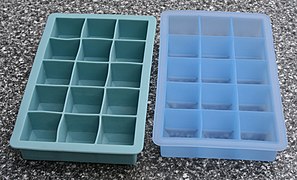Silicone
This article includes a list of general references, but it lacks sufficient corresponding inline citations. (July 2021) |
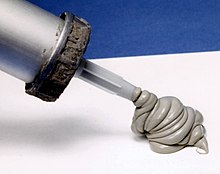
In
Chemistry

Alfred Stock and Carl Somiesky examined the hydrolysis of dichlorosilane, a reaction that was proposed to initially give the monomer H2SiO:
Most polysiloxanes feature organic substituents, e.g., [(CH3)2SiO]n and [(C6H5)2SiO)]n. All
Terminology and history
Silicone is often confused with silicon, but they are distinct substances. Silicon is a chemical element, a hard dark-grey semiconducting metalloid, which in its crystalline form is used to make integrated circuits ("electronic chips") and solar cells. Silicones are compounds that contain silicon, carbon, hydrogen, oxygen, and perhaps other kinds of atoms as well, and have many very different physical and chemical properties.
Compounds containing silicon–oxygen double bonds, now called
Synthesis
Most common are materials based on polydimethylsiloxane, which is derived by hydrolysis of dimethyldichlorosilane. This dichloride reacts with water as follows:
The polymerization typically produces linear chains capped with Si−Cl or Si−OH (silanol) groups. Under different conditions, the polymer is a cyclic, not a chain.[1]
For consumer applications such as caulks silyl acetates are used instead of silyl chlorides. The hydrolysis of the acetates produces the less dangerous acetic acid (the acid found in vinegar) as the reaction product of a much slower curing process. This chemistry is used in many consumer applications, such as silicone caulk and adhesives.
Branches or crosslinks in the polymer chain can be introduced by using organosilicone precursors with fewer alkyl groups, such as methyl trichlorosilane and methyltrimethoxysilane. Ideally, each molecule of such a compound becomes a branch point. This process can be used to produce hard silicone resins. Similarly, precursors with three methyl groups can be used to limit molecular weight, since each such molecule has only one reactive site and so forms the end of a siloxane chain.
Combustion
When silicone is burned in air or oxygen, it forms solid silica (
Properties
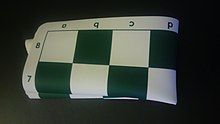
Silicones exhibit many useful characteristics, including:[1]
- Low thermal conductivity
- Low chemical reactivity
- Low toxicity
- Thermal stability (constancy of properties over a wide temperature range of −100 to 250 °C)
- The ability to repel water and form watertight seals.
- Does not stick to many substrates, but adheres very well to others, e.g. glass
- Does not support microbiologicalgrowth
- Resistance to creasing and wrinkling
- Resistance to oxygen, ozone, and ultraviolet (UV) light. This property has led to the widespread use of silicones in the construction industry (e.g. coatings, fire protection, glazing seals) and the automotive industry (external gaskets, external trim).
- Electrical insulationproperties. Because silicone can be formulated to be electrically insulative or conductive, it is suitable for a wide range of electrical applications.
- High gas permeability: at room temperature (25 °C), the permeability of silicone rubber for such gases as oxygen is approximately 400 times[10] that of butyl rubber, making silicone useful for medical applications in which increased aeration is desired. Conversely, silicone rubbers cannot be used where gas-tight seals are necessary such as seals for high-pressure gasses or high vacuum.
Silicone can be developed into rubber sheeting, where it has other properties, such as being FDA compliant. This extends the uses of silicone sheeting to industries that demand hygiene, for example, food and beverage, and pharmaceuticals.
Applications
Silicones are used in many products. Ullmann's Encyclopedia of Industrial Chemistry lists the following major categories of application: Electrical (e.g. insulation), electronics (e.g., coatings), household (e.g., sealants and cooking utensils), automobile (e.g. gaskets), airplane (e.g., seals), office machines (e.g. keyboard pads), medicine and dentistry (e.g. tooth impression molds), textiles and paper (e.g. coatings). For these applications, an estimated 400,000 tonnes of silicones were produced in 1991.[clarification needed] Specific examples, both large and small are presented below.[1]
Automotive

In the
Automotive spark plug wires are insulated by multiple layers of silicone to prevent sparks from jumping to adjacent wires, causing misfires. Silicone tubing is sometimes used in automotive intake systems (especially for engines with
Sheet silicone is used to manufacture
Automotive body manufacturing plants and paint shops avoid silicones, as trace contamination may cause "fish eyes", which are small, circular craters which mar a smooth finish.[citation needed]
Additionally, silicone compounds such as silicone rubber are used as coatings and sealants for airbags; the high strength of silicone rubber makes it an optimal adhesive and sealant for high impact airbags.[citation needed] Silicones in combination with thermoplastics provide improvements in scratch and mar resistance and lowered coefficient of friction.[citation needed]
Aerospace
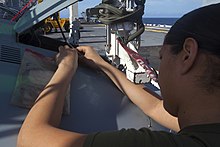
Silicone is a widely used material in the aerospace industry due to its sealing properties, stability across an extreme temperature range, durability, sound dampening and anti-vibration qualities, and naturally flame retardant properties. Maintaining extreme functionality is paramount for passenger safety in the aerospace industry, so each component on an aircraft requires high-performance materials.
Specially developed aerospace grades of silicone are stable from −70 to 220 °C,[11] these grades can be used in the construction of gaskets for windows and cabin doors. During operation, aircraft go through large temperature fluctuations in a relatively short period of time; from the ambient temperatures when on the ground in hot countries to sub-zero temperatures when flying at high altitude. Silicone rubber can be molded with tight tolerances ensuring gaskets form airtight seals both on the ground and in the air, where atmospheric pressure decreases.
Silicone rubber's resistance to heat corrosion enables it to be used for gaskets in aircraft engines where it will outlast other types of rubber, both improving aircraft safety and reducing maintenance costs. The silicone acts to seal instrument panels and other electrical systems in the cockpit, protecting printed circuit boards from the risks of extreme altitude such as moisture and extremely low temperature. Silicone can be used as a sheath to protect wires and electrical components from any dust or ice that may creep into a plane's inner workings.
As the nature of air travel results in much noise and vibration, powerful engines, landings, and high speeds all need to be considered to ensure passenger comfort and safe operation of the aircraft. As silicone rubber has exceptional noise reduction and anti-vibration properties, it can be formed into small components and fitted into small gaps ensuring all equipment can be protected from unwanted vibration such as overhead lockers, vent ducts, hatches, entertainment system seals, and LED lighting systems.
Solid propellant
Polydimethylsiloxane (PDMS) based binders along with ammonium perchlorate (NH4ClO4) are used as fast burning solid propellants in rockets.[12]
Building construction
The strength and reliability of silicone rubber are widely acknowledged in the construction industry. One-part silicone sealants and caulks are in common use to seal gaps, joints and crevices in buildings. One-part silicones cure by absorbing atmospheric moisture, which simplifies installation. In plumbing, silicone grease is typically applied to O-rings in brass taps and valves, preventing lime from sticking to the metal.
Structural silicone has also been used in curtain wall building façades since 1974 when the Art Institute of Chicago became the first building to receive exterior glass fixed only with the material.[citation needed] Silicone membranes have been used to cover and restore industrial roofs, thanks to its extreme UV resistance, and ability to keep their waterproof performance for decades.[citation needed]
3D printing
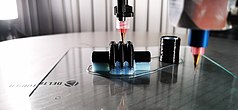
Silicone rubber can be 3D printed (liquid deposition modelling LDM) using pump-nozzle extrusion systems. Unfortunately, standard silicone formulations are optimized to be used by extrusion and injection moulding machines and are not applicable in LDM-based 3D printing. The rheological behavior and the pot life need to be adjusted.[13]
3D printing also requires the use of a removable support material that is compatible with the silicone rubber.
Coatings
Silicone films can be applied to such silica-based substrates as glass to form a
Many fabrics can be coated or impregnated with silicone to form a strong, waterproof composite such as silnylon.
A silicone polymer can be suspended in water by using stabilizing surfactants. This allows water-based formulations to be used to deliver many ingredients that would otherwise require a stronger solvent, or be too viscous to use effectively. For example, a waterborne formulation using a silane's reactivity and penetration ability into a mineral-based surface can be combined with water-beading properties from a siloxane to produce a more-useful surface protection product.
Cookware
As a low-taint, non-toxic material, silicone can be used where contact with food is required. Silicone is becoming an important product in the
Other products include
-
Soup ladle and pasta ladle made of silicone
-
A silicone foodsteamerto be placed inside a pot of boiling water
-
Flexible ice cube trays made of silicone allow easy extraction of ice.
-
Silicone brush used for basting and applying flavoring liquids
Defoaming
Silicones are used as active compounds in defoamers due to their low water solubility and good spreading properties.
Dry cleaning
Liquid silicone can be used as a
Electronics

Electronic components are sometimes encased in silicone to increase stability against mechanical and electrical shock, radiation and vibration, a process called "potting". Silicones are used where durability and high performance are demanded of components under extreme environmental conditions, such as in space (satellite technology). They are selected over polyurethane or epoxy encapsulation when a wide operating temperature range is required (−65 to 315 °C). Silicones also have the advantage of little exothermic heat rise during cure, low toxicity, good electrical properties, and high purity.
Silicones are often components of
The use of silicones in electronics is not without problems, however. Silicones are relatively expensive and can be attacked by certain solvents. Silicone easily migrates as either a liquid or vapor onto other components. Silicone contamination of electrical switch contacts can lead to failures by causing an increase in contact resistance, often late in the life of the contact, well after any testing is completed.[14][15] Use of silicone-based spray products in electronic devices during maintenance or repairs can cause later failures.
Firestops

Silicone foam has been used in North American buildings in an attempt to firestop openings within the fire-resistance-rated wall and floor assemblies to prevent the spread of flames and smoke from one room to another. When properly installed, silicone-foam firestops can be fabricated for building code compliance. Advantages include flexibility and high dielectric strength. Disadvantages include combustibility (hard to extinguish) and significant smoke development.
Silicone-foam firestops have been the subject of controversy and press attention due to smoke development from pyrolysis of combustible components within the foam, hydrogen gas escape, shrinkage, and cracking. These problems have led to reportable events among licensees (operators of nuclear power plants) of the Nuclear Regulatory Commission (NRC).[citation needed]
Silicone firestops are also used in aircraft.
Jewelry
Silicone is a popular alternative to traditional metals (such as silver and gold) with jewelry, specifically rings. Silicone rings are commonly worn in professions where metal rings can lead to injuries, such as electrical conduction and ring avulsions.[16][17] During the mid-2010's, some professional athletes began wearing silicone rings as an alternative during games.[18]
Lubricants
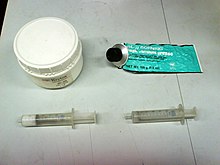
Silicone greases are used for many purposes, such as bicycle chains, airsoft gun parts, and a wide range of other mechanisms. Typically, a dry-set lubricant is delivered with a solvent carrier to penetrate the mechanism. The solvent then evaporates, leaving a clear film that lubricates but does not attract dirt and grit as much as an oil-based or other traditional "wet" lubricant.
Silicone personal lubricants are also available for use in medical procedures or sexual activity.
Medicine and cosmetic surgery
Silicone is used in
Illicit cosmetic silicone injections may induce chronic and definitive silicone blood diffusion with dermatologic complications.[19]
Ophthalmology uses many products such as silicone oil used to replace the
Addition and condensation (e.g. polyvinyl siloxane) silicones find wide application as a dental impression material due to its hydrophobic property and thermal stability.[20][21][22]
Moldmaking
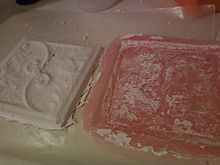
Two-part silicone systems are used as rubber molds to cast resins, foams, rubber, and low-temperature alloys. A silicone mold generally requires little or no mold-release or surface preparation, as most materials do not adhere to silicone. For experimental uses, ordinary one-part silicone can be used to make molds or to mold into shapes. If needed, common vegetable cooking oils or petroleum jelly can be used on mating surfaces as a mold-release agent.[23]
Silicone cooking molds used as
Personal care
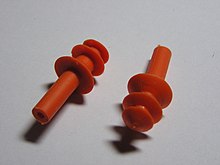
Silicones are ingredients widely used in skincare, color cosmetic and hair care applications. Some silicones, notably the amine functionalized amodimethicones, are excellent hair conditioners, providing improved compatibility, feel, and softness, and lessening frizz. The phenyl dimethicones, in another silicone family, are used in reflection-enhancing and color-correcting hair products, where they increase shine and glossiness (and possibly impart subtle color changes). Phenyltrimethicones, unlike the conditioning amodimethicones, have refractive indices (typically 1.46) close to that of a human hair (1.54). However, if included in the same formulation, amodimethicone and phenyltrimethicone interact and dilute each other, making it difficult to achieve both high shine and excellent conditioning in the same product.[24]
Silicone rubber is commonly used in baby bottle nipples (teats) for its cleanliness, aesthetic appearance, and low extractable content.
Silicones are used in
Toys and hobbies

Silicone "rubber bands" are a long-lasting popular replacement refill for real rubber bands in the 2013 fad "rubber band loom" toys at two to four times the price (in 2014). Silicone bands also come in bracelet sizes that can be custom embossed with a name or message. Large silicone bands are also sold as utility tie-downs.
Oogoo is an inexpensive silicone clay, which can be used as a substitute for Sugru.[27]
In making aquariums, manufacturers now commonly use 100% silicone sealant to join glass plates. Glass joints made with silicone sealant can withstand great pressure, making obsolete the original aquarium construction method of angle-iron and putty. This same silicone is used to make hinges in aquarium lids or for minor repairs. However, not all commercial silicones are safe for aquarium manufacture, nor is silicone used for the manufacture of acrylic aquariums as silicones do not have long-term adhesion to plastics.[28]
Production and marketing
The leading global manufacturers of silicone base materials belong to three regional organizations: the European Silicone Center (CES) in
Safety and environmental considerations
Silicone compounds are pervasive in the environment. Particular silicone compounds, cyclic siloxanes
At around 200 °C (392 °F) in an oxygen-containing atmosphere, PDMS releases traces of formaldehyde (but lesser amounts than other common materials such as polyethylene.[36][37]) At this temperature, silicones were found to have lower formaldehyde generation than mineral oil and plastics (less than 3 to 48 µg CH2O/(g·hr) for a high consistency silicone rubber, versus around 400 µg CH2O/(g·hr) for plastics and mineral oil). By 250 °C (482 °F), copious amounts of formaldehyde have been found to be produced by all silicones (1,200 to 4,600 µg CH2O/(g·hr)).[37]
See also
References
- ^ ISBN 978-3527306732.
- ISBN 9781119631378.
- ^ Seyferth, D., Prud'Homme, C., Wiseman, G., Cyclic Polysiloxanes from the Hydrolysis of Dichlorosilane, Inorganic Chemistry, 22, 2163-2167
- ISBN 978-0-08-037941-8.
- .
- ISBN 978-0-19-535131-6. Archivedfrom the original on 18 December 2017.
- .
- .
- ^ Additive manufacturing of ceramics from preceramic polymers: A versatile stereolithographic approach assisted by thiol-ene click chemistry. Additive Manufacturing, (2019) volume 27, pp. 80–90.
- S2CID 241551199, retrieved 2021-03-16
- ^ "Aerospace | Viking Extrusions". www.vikingextrusions.co.uk. Retrieved 2019-04-11.
- ISSN 0721-3115.
- S2CID 146407873.
- ISBN 978-0-8247-1934-0. Archivedfrom the original on 2017-12-18.
- .
- ^ Ashley, Sarah (August 1, 2018). "Is the Silicone Ring Trend Here to Stay?".
- ^ Chen, Connie. "A ton of couples are skipping the fancy wedding rings and opting for these $20 rubber bands instead — here's why". Insider.
- ^ "The (wedding) ring's the thing: Silicone bands a growing trend in NFL". ESPN.com. September 29, 2016.
- PMID 30681578.
- ^ "The many uses of dental impression silicone". July 19, 2022. Retrieved January 16, 2023.
- OCLC 45604030.
- OCLC 1124496192.)
{{cite book}}: CS1 maint: location missing publisher (link) CS1 maint: others (link - ^ Robyn Lish. What are the benefits of Silicone Caulk Moulds. Myheap.com. Retrieved on 2021-08-08.
- .
- ^ " "Formerol/Sugru technical data sheet".
- ^ "How to Make Your Own Sugru Substitute". Instructables.
- ^ "Aquarium Silicone Applications". Aquarium-pond-answers.com. March 2007. Archived from the original on 2012-03-15. Retrieved 2012-02-28.
- ^ "REACH consortium". Reach.silicones.eu. Archived from the original on 2012-03-15. Retrieved 2012-02-28.
- ^ Bienkowski, Brian (30 April 2013). "Chemicals from Personal Care Products Pervasive in Chicago Air". Scientific American. Archived from the original on 20 June 2015. Retrieved 8 April 2015.
- ^ European Chemicals Agency. "Committee for Risk Assessment concludes on restricting D4 and D5". European Chemicals Agency. Retrieved 28 August 2018.
- ^ "ECHA classifies cyclic siloxanes as SVHCs". Food Packaging Forum Foundation. 25 June 2018. Retrieved 28 August 2018.
- ^ S. Varaprath, K. L. Salyers, K. P. Plotzke and S. Nanavati: "Identification of Metabolites of Octamethylcyclotetrasiloxane (D4) in Rat Urine", Drug Metab Dispos 1999, 27, 1267-1273.
- ^ S. M. Sieburth, T. Nittoli, A. M. Mutahi and L. Guo: Silanediols: a new class of potent protease inhibitors, Angew. Chem. Int. Ed. 1998, volume 37, 812-814.
- ^ M. Blunder, N. Hurkes, M. List, S. Spirk and R. Pietschnig: Silanetriols as in vitro AChE Inhibitors, Bioorg. Med. Chem. Lett. 2011, volume 21, 363-365.
- ^ Hard, Dave. "Dielectric Fluids for Transformer Cooling — History and Types". General Electric. Archived from the original on 2016-07-19.
- ^ a b David C. Timpe Jr. Formaldehyde Generation from Silicone Rubber Archived 2015-04-27 at the Wayback Machine Arlon
External links
 Media related to Silicones at Wikimedia Commons
Media related to Silicones at Wikimedia Commons
- Science of Silicone Polymers (Silicone Science On-line, Centre Européen des Silicones: CES)
- Is Silicone Eco-friendly? (The Uptide)


![{\displaystyle n\ {\ce {Si(CH3)2Cl2}}+n\ {\ce {H2O -> [Si(CH3)2O]}}_{n}+2n\ {\ce {HCl}}}](https://wikimedia.org/api/rest_v1/media/math/render/svg/e58d75136d89d5f7b9f4cee09a3f9c7965829fe8)
![{\displaystyle n\ {\ce {Si(CH3)2(CH3COO)2}}+n\ {\ce {H2O -> [Si(CH3)2O]}}_{n}+2n\ {\ce {CH3COOH}}}](https://wikimedia.org/api/rest_v1/media/math/render/svg/436cedfc1dd4bb4373f950dce2364b44087d4b75)
